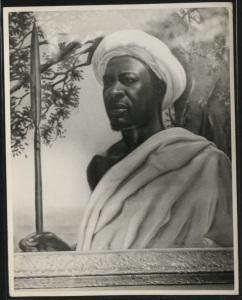
Have you ever heard about the German Schutztruppe‘s first stinging defeat in Africa? Have you ever heard about the African Chief whose skull was part of the Treaty of Versailles’ negotiation? Have you ever heard of the Hehe Rebellion of 1891 and the German defeat at the hand of the fierce Hehe King Mkwawa in Lugalo?
King Mkwavinyika Munyigumba Mwamuyinga (known as Mkwawa) was born in Luhota in Iringa in the south of modern-day Tanzania, and was the son of Chief Munyigumba, who died in 1879. He was the leader of the Hehe people in German East Africa (now mostly the mainland part of Tanzania) who opposed the German colonization. The name “Mkwawa” is derived from Mukwava, itself a shortened form of Mukwavinyika, meaning “conqueror of many lands“.
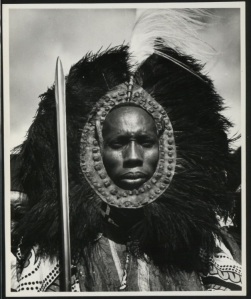
Mkwawa was the chief of the Uhehe who won fame by defeating Germans at Lugalo on August 17th 1891 and maintaining the resistance for seven years. August 17th 1891 marks the first defeat of the German colonial troops or ‘Schutztruppe’ in Africa, at Africans’ hands. The devotion of the Hehe people to their King was unconditional to the point that when the German governor offered 5,000 rupees for his capture in 1898, no Hehe accepted it!
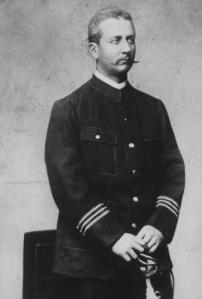
After the Germans had managed to colonize the coastal area of Tanganyika (modern-day Tanzania), they started to move further inland. At that time the Hehe were also expanding towards the coast. Both sides tried some diplomacy to avoid war. However, all hopes were dashed, so the Germans decided the best way was to fight against Chief Mkwawa. In July 1891, the German commissioner, Emil von Zelewski, led a battalion of soldiers (320 askaris with officers and porters) to suppress the Hehe. On 17 August, they were attacked by Mkwawa’s 3,000-strong army at Lugalo, who, despite only being equipped with spears and a few guns, quickly overpowered the German force and killed Zelewski.
On 28 October 1894, the Germans, under the new commissioner Colonel Freiherr Friedrich von Schele, attacked Mkwawa’s fortress at Kalenga. Although they took the fort, Mkwawa managed to escape. Subsequently, Mkwawa conducted a campaign of guerrilla warfare, harassing the Germans until 1898 when, on 19 July, he was surrounded and he shot himself to avoid capture.
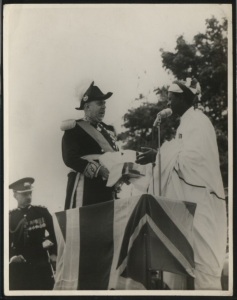
After his death, German soldiers removed Mkwawa’s head. The skull was sent to Berlin and ended up in the Übersee-Museum Bremen. In 1918 the then British Administrator of German East Africa H.A. Byatt proposed to his government that it should demand a return of the skull to Tanganyika in order to reward the Wahehe for their cooperation with the British during the war and in order to have a symbol assuring the locals of the definitive end of German power. The skull’s return was stipulated in the 1919 Treaty of Versailles:
“ARTICLE 246. Within six months from the coming into force of the present Treaty, … Germany will hand over to His Britannic Majesty’s Government the skull of the Sultan Mkwawa which was removed from the Protectorate of German East Africa and taken to Germany.”
The Germans disputed the removal of the said skull from East Africa and the British government took the position that the whereabouts could not be traced. However, after World War II, the Governor of Tanganyika, Sir Edward Twining, took up the issue again. After inquiries he was directed to the Bremen Museum which he visited himself in 1953. The Museum had a collection of 2000 skulls, 84 of which originated from the former German East Africa . He short-listed the ones which showed measurements similar to surviving relatives of Chief Mkwawa; from this selection he picked the only skull with a bullet-hole as the skull of chief Mkwawa.
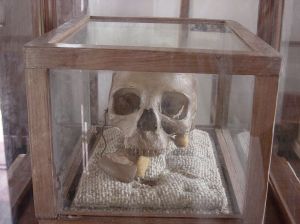
The skull was finally returned on 9 July 1954, and now resides at the Mkwawa Memorial Museum in Kalenga, near the town of Iringa. Many believe that it is not King Mkwawa’ skull.
Here I salute King Mkwawa and the Hehe people who fought for their freedom and resisted for over 7 years. The defeat of the German colonial forces on 17th August 1891 in Lugalo, the destruction of the Hehe fort at Kalenga on the 30th of October 1894 and the death of Chief Mkwawa on the 19th of June 1898 were key events in the German colonization in East Africa. To learn more about this page of history, check out the website by King Mkwawa’s great-grandson, The colonial wars of imperial Germany , and this article on King Mkwawa’s skull.


What a phenomenal story, Dr. Y. I have read/seen documentaries of the Schutztruppe’s shameful doings in Namibia, but did not know about Mkwawa. The taking of his skull was an appallingly disrespectful act, and by Europeans who were too inclined to call African people uncivilized.
LikeLike
You are absolutely right Tish. The taking of his skull was an appallingly disrespectful act.
LikeLiked by 1 person
Thank YU so much. Can I use this?
LikeLike
Absolutely. Please do!
LikeLike
Who by that time was the first European to take Mkwawas body?
Also who was succeeded to defeat Mkwawa?
LikeLike
Thank you Mpita Ally. These are very good questions which require further investigation. The information about the first European to take Mkwawa’s head could possibly be in the archives of the German Schutztruppe or those about German East colonial empire somewhere in Berlin.
LikeLike
It is not clear how the skull of Mkwawa was preserved in German, who was responsible for taking care through out the years, or which institution in German was responsible for taking care of the Mkwawa’s skull. And how can we proof that, that is the real skull of Mkwawa.
LikeLike
Very good questions Fidelis… The skull was preserved in the Übersee-Museum Bremen (Overseas Museum of Bremen in Germany). Even after the signing of the Versailles Treaty, it was not returned until much later in 1954… In 1953, the British governor went to look for it at the museum, and found that out of 2000 skulls, 84 were from Tanganyika… then they measured the sizes of skulls, and compared with living relatives of King Mkwawa, to find the correct skull.
As I have said before for the skulls of Namibian victims of the first German genocide of the 20th century, I am not even sure that these skulls that the Europeans are finally returning are the real ones… why did it take so long to return?… Is there a better way to verify?
LikeLike